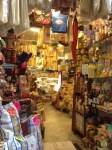 Naples, Napoli in Italian, is the third most-populated city in Italy and the biggest city in Southern Italy. Its close proximity to many interesting sites, such as Pompeii and the Bay of Naples, makes it a good base for exploring the area. Naples is a lively and vibrant city, full of wonderful historical and artistic treasures and narrow, winding streets with small shops, making it worth at least a few days visit.
Naples, Napoli in Italian, is the third most-populated city in Italy and the biggest city in Southern Italy. Its close proximity to many interesting sites, such as Pompeii and the Bay of Naples, makes it a good base for exploring the area. Naples is a lively and vibrant city, full of wonderful historical and artistic treasures and narrow, winding streets with small shops, making it worth at least a few days visit.
During my late January visit to Italy, I was priviledged to be one of ten American guests invited to partake in a 4 day educational program highlighting the history, arts, culture, and cuisine of Naples. It had been many years since I had visited Naples with locals and I was rewarded with a renewed enthusiasm for this magical city that is rich in history, traditions, art and breathtaking views, not to mention the culinary highlights. Mayor Luigi de Magistris and Antonella Di Nocera, head of Tourism and Culture, and her welcoming staff prepared an incredible ‘Grand Tour of Naples’ for us and personally joined in on much of the agenda.
The National Archaeological Museum of Naples has one of the world’s best collections of Greek and Roman antiquities, including mosaics, sculptures, gems, glass and silver, and a collection of Roman erotica from Pompeii. Many of the objects come from excavations at Pompeii and other nearby archaeological sites. Piazza del Plebiscito is the center of modern Naples. San Francesco di Paola, on the piazza, is a huge domed church. Palazzo Reale, the Royal Palace, is across the square. Spaccanapoli, or Via San Biagio, is the main street that divides Naples and is the heart of the historic center. Originally the heart of the Greek and Roman city, the Spaccanapoli district is a string of narrow, winding streets teeming with people in this mainly pedestrian zone. Via San Gregorio Armeno, off Via San Biagio, is famous for its nativity workshops and stores. Via dei Tribunali, another street in old Naples, has arcades dating back more than 1000 years.
Santa Chiara Church and Monastery were built in the 14th century. The original church, built in Provencal Gothic style, was the largest Clarissan church ever built. It has beautiful cloisters decorated with majolica tiles and frescoes. The church holds the tombs of several kings and queens as well as relics of Saint Louis of Toulouse.
The Capodimonte Museum and Park, built as King Charles III’s hunting lodge, houses one of Italy’s richest museums with a great picture gallery and collection of majolica and porcelain.
Via Toledo, a pedestrian street, is one of the main business and shopping streets. Unfortunately, shopping was not on the busy agenda. Castel dell’Ovo, the oldest castle in Naples, sits in a prominent position on the harbor and is used for exhibitions and concerts. My room in Hotel Santa Lucia had a marvelous view on the Bay of Naples and Castel dell’Ovo.
Castel Nuovo, a huge castle erected in 1279-1282, houses the Civic Museum with 14th-15th century frescoes and paintings, silver, and bronzes from the 15th century to present.
Stay tuned for my next posts on the San Carlo Opera House, the oldest in Europe, Galleria Umberto and my first ride on Italo, Italy’s new ‘bullet train’.














Leave a comment